Almost spring. August 20 1860. A good day to walk across the continent. The Argus doesn’t mention the weather (the first Australian weather map published in a newspaper was in 1877) but I imagine the air would be getting cold at 4pm as Burke and Wills and crew departed from Royal Park, surrounded by thousands of well wishers.
Artist William Strutt painted many pictures of the expedition, but it was The Burke and Wills expedition: the first day’s order of march (below) that caught my eye. The expedition included 19 men, 27 camels and 23 horses which carried over two years worth of supplies and an enormous amount of equipment. ‘In Joseph Furphy’s novel Such is Life (1897), a yarn-spinning bullock driver claims to have seen Burke at Menindie with a carpet, a bedstead and a specially-constructed carrying case for his top hat.’ (Dig).

The painting reminds me of the images of the European settlement of North America- the advancing colonists making their way west; the line of wagons, the people and animals stepping out thousands of kilometres. Although it is not a large picture (12.4 x 49.2 cm), by setting the expedition crew back in the landscape, at a distance from the viewer, the land becomes the dominant element. As the explorer’s queue rolls over the horizon, they turn at a right angle to cross our eye line. This creates a huge square of empty space, where land and sky merge and space seems endless.
Both people and animals are surrounded by the featureless land- the daunting reality facing this slim crew of explorers. You can imagine the scene could be anywhere on their trip to the Gulf of Carpentaria as the land mass would not shrink across the continent- unlike the expedition party.
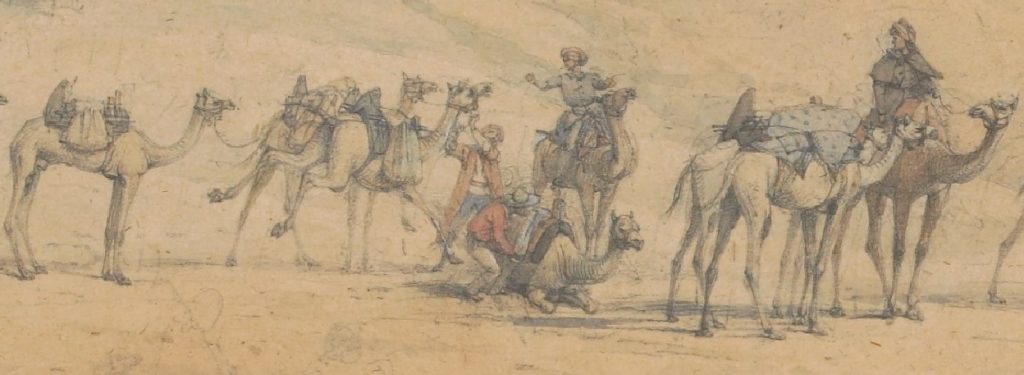
The painting also illustrates Strutt’s fondness and deft touch in drawing animals, (he would later travel to Africa to study animals). The camels in the above detail are shown from a number of angles; from side to rear to front on- and in different poses including standing, kicking, kneeling and turning. Here Strutt has used the painting to provide a 360 degree study of the camel.
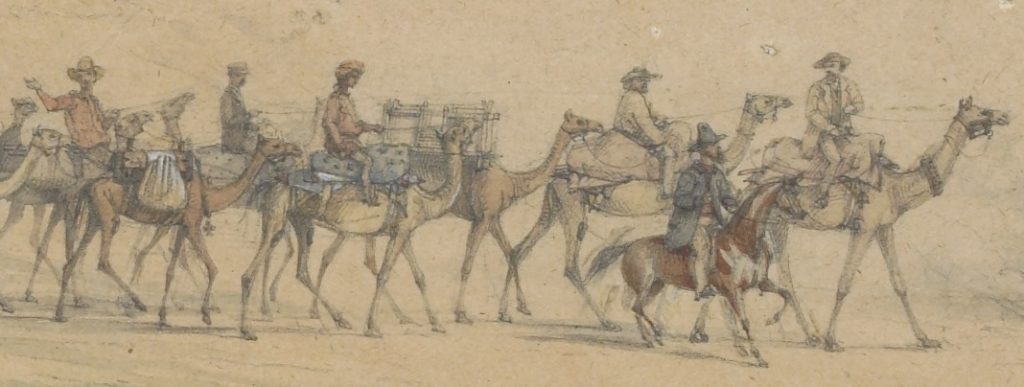
The Burke and Wills expedition… also features many characters spanning a wide geography- a style repeated in some of Strutt’s other works such as Black Thursday, (below) which captures the widespread Victorian bush fires of 1851.
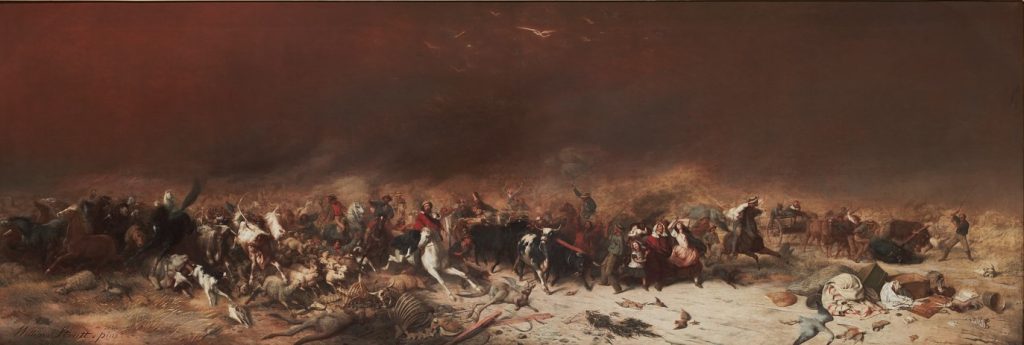
Black Thursday, February 6th. 1851; H28049
In another Burke and Wills image, The parting cheer, (below) Strutt captures a chaotic, claustrophobic leaving scene- with the huge crowds gathered, animals out of control and a seemingly frustrated Robert Burke determined to get the expedition going- like a parent waiting in the car to begin their holiday. It wouldn’t surprise after this scene if the party longed for the open plains of northern Victoria- although their first stop would only be down the road at Essendon. Leaving so late in the day was probably not the ideal start to a 2500km journey.
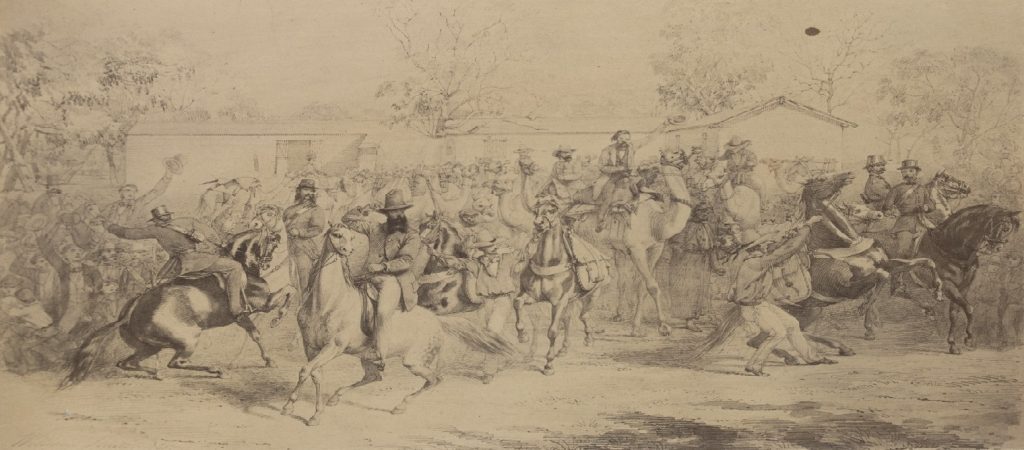
The Library has a dedicated website to the expedition, Dig: the Burke and Wills research gateway, as well as other Strutt resources. The State Library of New South Wales has digitised and album of Strutt’s drawings illustrating the expedition.

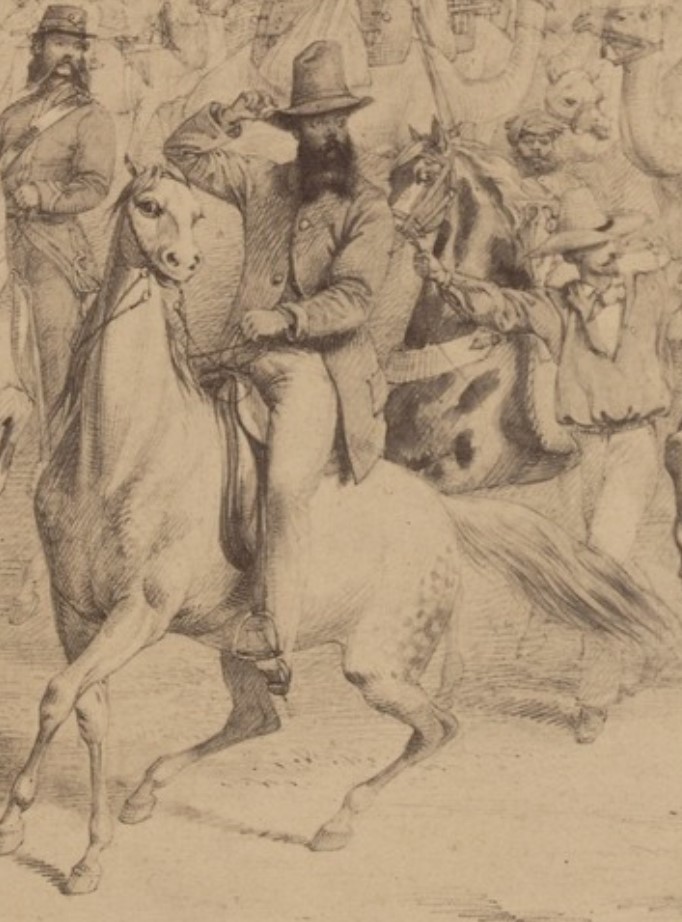

A really enjoyable and informative read using Strutt’s painting as a guide. Thank you!
Thanks Susan!
Paul
Thankyou SLV . I love these glimpses of history that you send out to us.
Thanks for the comment and reading the blog June.
Paul
Your blog accounts for 27 camels.
However, the Argus, 11 June cites 24 camels imported from Kurrachee (Karachi) by the Victorian Government with Landells.
https://trove.nla.gov.au/newspaper/article/5684078
Can you explain the 3 other camels?
Also, is there an image of Dost Mahomet by William Strutt?
Thank you
Hi Sandra,
There seems to be a number of varying reports of camel numbers. The National Museum of Australia states 27, as does the Burke and Wills Archive, and the State Library of NSW:
https://www.nma.gov.au/defining-moments/resources/burke-and-wills
http://www.burkeandwills.net.au/Camels/Expedition_Camels.htm
https://www.sl.nsw.gov.au/stories/burke-and-wills
Whilst the Public Record Office of Victoria cites 26
https://prov.vic.gov.au/explore-collection/provenance-journal/provenance-2010/what-happened-camels-burke-and-wills
There seems to be a difference depending on when the numbers were counted.
State Library Victoria does not hold an image of Dost Mahomet by William Strutt. There is one credited in the below album -held by by State Library of New South Wales
https://collection.sl.nsw.gov.au/record/nZNvEaQn
Paul
For Sandra:
The Burke and Wills Expedition departed Royal Park with 26 camels.
Landells arrived in Melbourne in June 1860 with 24 camels from Karachi, but six camels had already landed in Melbourne the previous year, These camels were imported from Aden in November 1859 by ‘Parsee Speculators’ in the hope that the Colonial Victorian Government would purchase them for the Victorian Exploring Expedition. The government declined, so George Coppin, the Melbourne theatrical empresario bought them and put them in his Cremorne Gardens Menagerie. Eventually the Victorian Government relented and bought the Cremorne ‘Egyptian’ camels for £50 each, and they were used on the Burke and Wills Expedition.
The Coppin camels were called: Siva, Krishna, Mr. Cassim, Janglee, and there were two male camels whose names were not recorded – one was a large gray camel that was missing part of his ear.
Landells’ camels and Coppin’s camels were not the first ones imported into Australia – at least 6 other camels had been brought to Australia befor 1859.
See: https://researchonline.jcu.edu.au/50833/1/50833-phoenix-2017-thesis.pdf
Hello Dave
Was unaware of your reply and apologise for not thanking you much sooner.
Have previously found your extensive thesis through my research on the ‘first’ Afghanistan settler in Australia which brought me to the Burke and Wills expedition.
My issue regarding the number of camels to set out from Royal Park is not merely pedantic but an effort to fact check old records that may have been incorrect and subsequently ‘copied and pasted’ as fact.
On the same page of the Argus, 11 June, 1860, there are 2 articles regarding the number of camels arrived at Melbourne; 21 and 24, 21 must have been a typo?
However, you may be able to sort out for me if there were nine or eight ‘camel attendants’ to arrive on the Chinsurah. The passenger manifest prints ‘nine’, hardly a typo. My reference sources always quote eight only?
I’ve found various birth dates for Dost Mahomet?
Thank you
Sandra
https://rgssa.blogspot.com/